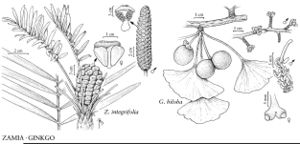Zamiaceae
Plants superficially palmlike or fernlike, perennial, evergreen, dioecious. Stems subterranean with exposed apex or aboveground, fleshy, stout, cylindric, simple or irregularly branched. Roots with small secondary roots; coral-like roots developing at base of stem at or below soil surface. Leaves pinnately compound, spirally clustered at stem apex, leathery, petiole and rachis unarmed [with stout spines]; leaflets entire or dentate [spinose], venation dichotomous [netted]; resin canals absent. Cones axillary, appearing terminal, short-peduncled [sessile], disintegrating at maturity; sporophylls densely crowded, spirally arranged, often covered with indument. Pollen cones soon shed, generally smaller and more numerous than seed cones; sporophylls bearing many crowded, small microsporangia (pollen sacs) adaxially; pollen spheric, not winged. Seed cones persistent for a year or more, 1(–2) per plant, nearly globose to ovoid, tapering sharply or blunt at apex; sporophylls peltate, thickened and laterally expanded distally, bearing 2(–3) ovules. Seeds angular, inner coat hardened, outer coat fleshy, often brightly colored; cotyledons 2.
Distribution
Primarily tropical to warm temperate regions, North Americ, Central America, South America, Africa, Australia.
Discussion
Genera 9, species ca. 100 (1 genus, 1 species in the flora).
Selected References
None.
